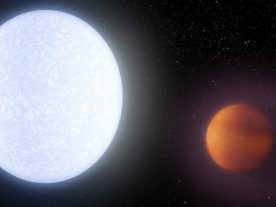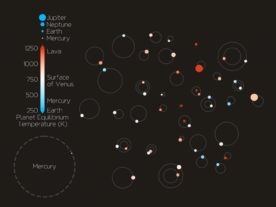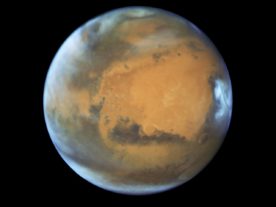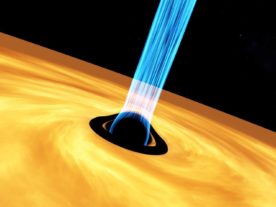
Artist's conception of exoplanet GJ1214b orbiting a red dwarf star 40 light-years from Earth (Photo: David A. Aguilar (CfA))
Data from the Hubble Space Telescope has revealed a new class of planet, one which is water-covered and has a steamy atmosphere.
We currently have three types of planets in our Solar System; rocky (Earth, Venus, Mercury and Mars), gas giants (Saturn and Jupiter) and ice giants (Uranus and Neptune).
While studying the exoplanet, GJ 1214b, astronomers found it to be like no other known planet because a significant portion of its mass is made up of water.
The GJ 1214b, discovered back in 2009, is about 2.7 times Earth’s diameter and weighs almost seven times as much.
GJ 1214b orbits a red-dwarf star every 38 hours at a distance of two million kilometers, and scientists estimate that it has a temperature of 230 degrees Celsius.
Scientists determined a type of haze that surrounds the planet is, most likely, the result of the planet’s steamy atmosphere.
Astronomers calculate the exoplanet has more water and is less rocky than Earth.
The astronomers say that GJ 1214b is located in the constellation of Ophiuchus (The Serpent Bearer), about 40 light-years from Earth.
Why Earth has active volcanoes while the moon doesn’t
Earth is in a constant state of change and evolution thanks in part to the active volcanism taking place throughout our planet.
The moon also has a history of volcano activity, but evidence of its volcanic past dates back billions of years.
So, if both the Earth and moon have a history of volcanism, why doesn’t the moon currently have active volcanoes?
Scientists are puzzled because many of the rocks on the moon’s surface are thought to be molten and recent moon-quake data suggests there is a huge supply of liquid magma deep within its surface.
A team of European scientists now thinks the reason the moon lacks current volcanic activity is because the magma – hot, molten rock deep within the moon’s interior – might be so dense that it is simply too heavy to rise to the surface.
The researchers created microscopic copies of moon rock collected by the Apollo missions and then melted them at the extremely high pressures and temperatures found inside the moon. They then measured the density of these melted rocks with powerful x-rays.
The scientists found small droplets of titanium-rich glass that produce a liquid magma as dense as the rocks that are found in the deepest parts of the lunar mantle today.
Scientists say, since the magma was so dense, it would not be able to move towards the surface the same way magma on Earth does during a volcanic eruption.
Ancient rock art found in Brazil

This is the oldest reliably dated petroglyph ever found in the New World. (Photo/Image: Neves WA, Araujo AGM, Bernardo DV, Kipnis R, Feathers JK (2012) Rock Art at the Pleistocene/Holocene Boundary in Eastern South America. PLoS ONE 7(2): e32228. doi:10.1371/journal.pone.0032228)
Back on Earth, researchers recently found an extremely old human-like figure engraved in rock in central Brazil.
The engraving, or petroglyph,was found in an ancient limestone rock shelter called Lapa do Santo.
According to the researchers’ report, the petroglyph dates back to between 9,000 and 12,000 years ago, which would make it the oldest reliably-dated specimen of this kind of rock art ever found in the Americas.
New World art produced during the time this discovery was engraved is quite rare. Because of the rarity of this type of rock art, scientists know little about the differences of symbolic thinking of those who settled the Americas thousands of years ago.
Authors of this study suggest symbolic thought in South America was very diverse at that time, and that their discovery shows humans settled the New World earlier than first thought.
Scientists find new life forms deep within the Earth’s surface
Scientists exploring what’s been called the world’s deepest cave say that they’ve found a new species of arthropod that lives and thrives deep underground.
The creature, Plutomurus ortobalaganensis, is a tiny, primitive, wingless and eyeless, six-legged insect which lives in total darkness.
The scientists say the discovery of life in such a deep environment should provide new insight into how we look at life on Earth.
Since they live without light and have extremely limited food resources, animals such as the Plutomurus ortobalaganensis have had to develop some uncommon methods of surviving in its subterranean environment.
The new creature was found 1,980 meters below ground level in the Krubera or Voronja Cave, located in Abkhazia, a remote area near the Black Sea in the mountains of Western Caucasus.
The Krubera/Voronja cave reaches a depth of more than two kilometers below the surface of the Earth.























Comments are closed.